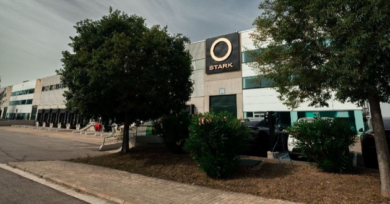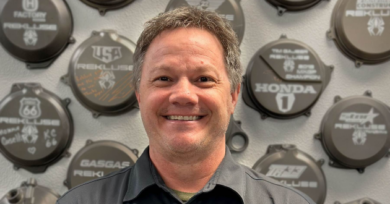Cannondale files Chaper 11
Motorsports operation to be sold by mid-March
Cannondale Corporation, the world renowned bicycle maker, has called it quits on powersports equipment. The Bethel, Conn., manufacturer filed for protection from creditors under Chapter 11 of the federal bankruptcy code Jan. 30. Assets and liabilities claimed in the filing were not available as this issue of Powersports Business was printed.
Cannondale’s wholly-owned subsidiaries in Europe, Japan and Australia ,which accounted for about 42% of total sales in 2002, were not included in the bankruptcy filing. The European unit includes an assembly plant and warehouse/office space. The other two are warehouse/sales facilities.
Coinciding with the bankruptcy filing, Cannondale accepted a $25 million bid for the assets of the company from Pegasus Partners II, L.P., a venture capital firm that was owed approximately $25 million. Pegasus loaned Cannondale $25 million last July.
The deal with Pegasus, called a stalking horse agreement, prohibits other interested buyers from bidding less than $25 million.
“There are strategic buyers within the powersports industry and there also are buyers on the bicycle side,” said Joe Montgomery, chairman, president and CEO, during a recent interview with Powersports Business. There also are several potential bidders from the investment community, but Montgomery declined to identify the potential buyers.
Cannondale had early struggles with its off-road motorcycle, but its high-performance ATVs were a stronger product in that market and were well received by enthusiast media and competitive owners. Limited retail sales of both products could not provide enough cash to offset the expense Cannondale incurred for research and development and machine production.
“We did a good job,” said Montgomery. “We were making money on a number of the products.” Montgomery declines to provide specific model-by-model profit margins, citing federal securities regulations governing full disclosure to all investors.
The company poured close to $80 million into the motorsports venture. The company invested approximately $11 million on research and development of motorsports products during fiscal years 2000 – 2002, according to a securities filing it made last September.
Cannondale showed its first motorsports product, the 397cc motorcross MX400 at the 1999 Dealer Expo. It carried an MSRP of $7,950.
Dealing with difficulties
“By far the most difficulties we had were with the engine,” says Montgomery. “Those put us behind on deliveries. And we had some warranty problems. But we had overcome those issues. Last year, we began shipping in significant amounts. The product was well received. The supermotard and the enduro — a number of motorcycles were being well received here and in Europe. And the quad was well received.
“We just couldn’t get anyone to put in anymore money. We tried to sell the division. We tried to get investors for the division, but we were unable to make it happen,” he said.
Montgomery said the company never forced product on its dealers, denying reports that dealers had to take four motorcycles for every ATV they received.
The company never thought about dropping the motorcycle line and concentrating on the quads, he said. “It was a good product and a number of reviews across the board were very positive,” he said. “And it wouldn’t have saved us any real money; it wouldn’t have fixed anything. In fact, the more products you ship, the more overhead you absorb. The motorcycle products were very well received, especially in Europe.”
The cash crunch came to light when Cannondale reported in its September 2002 annual securities filing that it had used approximately $10.3 million of the proceeds of the Pegasus financing to pay off previous loans. It then noted that the remaining $11.7 million “have been used for working capital needs.”
For the year ended June 29, the company had sales of $156.6 million, including $134.6 million from bicycles and $22 million from motorsports.
As cash became tighter, the company fell behind with many of its suppliers, even those on the bicycle side. When that happened, suppliers began demanding COD. “If they wanted $10,000 in materials,” said one supplier, “I wanted $20,000 to pay down part of the debt.”
Why the move to motorsports?
Joe Montgomery put it succinctly when he told Powersports Business in March 2001: “In 1996, we saw the bicycle market beginning to mature. We have a very growth-oriented group here; we’re a very energetic company. And I was looking at what was next to keep Cannondale growing.”
And, he added, “We had the skills to build the product. We’re very good with aluminum; we know how to work with it. And we know suspension.”
But perhaps his key comment was this one: “We didn’t know squat (about engines), and, to begin with, that’s where we fell down.” Cannondale couldn’t buy a motor and bolt it on its own aluminum frame; that wasn’t in its corporate DNA. It needed — wanted — its own proprietary engine.
A Difficult ending
Why did Cannondale’s motorsports venture fail? Many reasons, say those close to the scene. But perhaps this scenario explains it best: A drive for perfection, coupled with inexperience on the engine side, led to multiple changes, late shipments and warranty problems. The premium pricing for the innovative four-stroke, fuel-injected machines with unique aluminum frames didn’t work well when powersports OEMs quickly added competitive products. And as bicycle sales slipped from $162 million in fiscal 2000 to $147 million and $157 million in the next two years, there was no cash to pump the motorsports production engine.
“Joe’s an entrepreneur,” says Francois Paranteau, a securities analyst. “The same skills needed to build a great bicycle company from scratch were the same ones needed here. But he may have received bad advice from the Street — bigger isn’t always better. And when they did it, they went out naked. They had a $20 stock and they could have sold one million shares and had $20 million to start (the project). One rule of thumb (for a startup) is that it takes twice as long as you think and twice as much (money) as you expect. I believe Joe didn’t have the cushion to keep innovating through the downturn.”
Paranteau adds a final note: “There really wasn’t anything proprietary about the fuel injection or the aluminum frame. Joe said their strength would be the ability to implement their ideas. But they didn’t have the financial backing to do it.”
Joe Montgomery, 63, has been the driving force at Cannondale since he began the company in 1971. Now, he’s not certain what the future holds for him.
“We gave it our best shot, and we still have believers out there. I have no idea what I’ll do. I will help out here as long as I can and as long as they need me to fulfill our obligations to creditors, stockholders and employees .”




